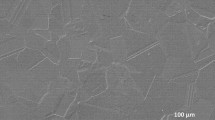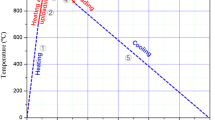Abstract
Conductive spring wires for application in electrical components require high strength, high electrical conductivity, and convenient manufacturability. Copper–indium (Cu–In) solid solution alloys are suitable candidates for such wires because they exhibit effective solid solution strengthening without significantly decreasing the conductivity. Herein, we systematically investigate the microstructure of Cu–In alloy wires fabricated by severe drawing, along with their mechanical and electrical properties. During the initial drawing stages, high-density deformation twins are generated in the Cu–In alloy because the In solute efficiently reduces the stacking fault energy (SFE) of the Cu matrix. These deformation twins promote grain refinement during subsequent drawing. The Cu–5.0 at. pct In alloy wire, drawn severely to an equivalent strain of 4.61, possesses ultrafine grains measuring 60 to 80 nm with a high density of dislocations, resulting in excellent yield strength, tensile strength, and conductivity of 1280 MPa, 1340 MPa, and 24 pct relative to the International Annealing Cu Standard, respectively. These properties were comparable to those of age-hardenable Cu–Be and Cu–Ti alloys; thus, our results demonstrate that tuning the In content of the Cu matrix to reduce the SFE and optimizing the deformation strain to refine the grain size significantly improves the performance of alloy wires.













Similar content being viewed by others
References
X. Guoliang, W. Qiangsong, M. Xujun, X. Baiqing, and P. Lijun: Mater. Sci. Eng. A, 2012, vol. 558, pp. 326–30.
Q. Lei, Z. Li, T. Xiao, Y. Pang, Z.Q. Xiang, W.T. Qiu, and Z. Xiao: Intermetallics, 2013, vol. 42, pp. 77–84.
S. Semboshi, Y. Kaneno, T. Takasugi, and N. Masahashi: Metall. Mater. Trans. A, 2018, vol. 49A, pp. 4956–65.
S.Z. Han, E.-A. Choi, S.H. Lim, S. Kim, and J. Lee: Prog. Mater. Sci., 2021, vol. 117, p. 100720.
S. Semboshi, R. Hariki, T. Shuto, H. Hyodo, Y. Kaneno, and N. Masahsshi: Metall. Mater. Trans. A, 2021, vol. 52A, pp. 4934–45.
K. Maki, Y. Ito, H. Matsunaga, and H. Mori: Scripta Mater., 2013, vol. 68, pp. 777–80.
Y. Li, Z. Xiao, Z. Li, Z. Zhou, Z. Yang, and Q. Lei: J. Alloys Compd., 2017, vol. 723, pp. 1162–70.
N. Tsuji, T. Toyoda, Y. Minamino, Y. Koizumi, T. Yamane, M. Komatsu, and M. Kiritani: Mater. Sci. Eng. A, 2003, vol. 350, pp. 108–16.
Y. Koizumi, M. Ueyama, N. Tsuji, Y. Minamino, and K. Ota: J. Alloys Compd., 2003, vol. 30, pp. 47–51.
S. Riedel, J. Röber, and T. Geßner: Microelectron. Eng., 1997, vol. 33, pp. 165–72.
H. Yoshinaga: Phys. Status Solidi, 1966, vol. 18, pp. 625–36.
J.W. Rutter and J. Reekie: Phys. Rev., 1950, vol. 78, pp. 70–71.
Y.H. Zhau, X.Z. Liao, Y.T. Zhu, Z. Horita, and T.G. Langdon: Mater Sci. Eng. A, 2005, vol. 410–411, pp. 188–93.
L. Balogh, T. Ungar, Y. Zhao, Y.T. Zhu, Z. Horita, C. Xu, and T.G. Langdon: Acta Mater., 2008, vol. 56, pp. 809–20.
Y.H. Zhao, X.Z. Liao, Z. Horita, T.G. Langdon, and Y.T. Zhu: Mater. Sci. Eng. A, 2008, vol. 15, pp. 123–29.
S. Qu, X.H. An, H.J. Yang, C.X. Huang, G. Yang, Q.S. Zang, Z.G. Wang, S.D. Wu, and Z.F. Zhang: Acta Mater., 2009, vol. 57, pp. 1586–1601.
R. Kumar, S.M. Dasharath, P.C. Kang, C.C. Koch, and S. Mula: Mater. Des., 2015, vol. 67, pp. 637–43.
B.B. Straumal, A.R. Kilmametov, G.A. Lopez, I. Lopez-Ferreno, M.L. No, J. San Juan, H. Hahn, and B. Baretzky: Acta Mater., 2017, vol. 125, pp. 274–85.
J.O. Linde: Helv. Phys. Acta, 1968, vol. 41, pp. 1007–15.
H.W. King: J. Mater. Sci., 1966, vol. 1, pp. 79–90.
P.C.J. Gallagher: Metall. Trans., 1970, vol. 1, pp. 2429–61.
Z.J. Zhang, Q.Q. Duan, X.H. An, S.D. Wu, G. Yang, and Z.F. Zhang: Mater. Sci. Eng. A, 2011, vol. 528, pp. 4259–67.
H. Bahmanpour, A. Kauffmann, M.S. Khoshkhoo, K.M. Youssef, S. Mula, J. Freudenberger, J. Eckert, R.O. Scattergood, and C.C. Koch: Mater. Sci. Eng. A, 2011, vol. 529, pp. 230–36.
A. Rohatgi, K.S. Vecchio, and G.T. Gray III.: Metall. Mater. Trans. A, 2001, vol. 32A, pp. 135–45.
N.M. Chavan, P.S. Phani, M. Ramakrishna, L. Venkatesh, P. Pant, and G. Sundararajan: Mater. Sci. Eng. A, 2021, vol. 814, p. 141242.
Z. Bahari, E. Dichi, B. Legendre, and J. Dugué: Thermochim. Acta, 2003, vol. 401, pp. 131–38.
S. Semboshi and T.J. Konno: J. Mater. Res., 2008, vol. 23, pp. 473–77.
The Japanese Institute of Metals and Materials (ed): Metals Data book, 4th ed. Maruzen Corporation, Tokyo, 2017, p. 43. (Japanese).
T.H. Davis and J.A. Rayne: Phys. Rev. B, 1972, vol. 6, pp. 2931–42.
J. Miyake and M.E. Fine: Acta Metall. Mater., 1992, vol. 40, pp. 733–41.
K. Nakanishi and H. Suzuki: Trans. JIM, 1974, vol. 15, pp. 435–40.
L. Cizek, P. Kratochochvil, and B. Smola: J. Mater. Sci., 1974, vol. 9, pp. 1517–20.
A. Studies, P.O. Box, and P.H. Uk: J. Mater. Sci., 1993, vol. 28, pp. 2557–76.
K.A. Weidenmann, R. Tavangar, and L. Weber: Mater. Sci. Eng. A, 2009, vol. 523, pp. 226–34.
N. Khobragade, K. Sikdar, B. Kumar, S. Bera, and D. Roy: J. Alloys Compd., 2019, vol. 776, pp. 123–32.
Y.B. Wang, X.Z. Liao, Y.H. Zhao, E.J. Lavernia, S.P. Ringer, Z. Horita, T.G. Langdone, and Y.T. Zhu: Mater. Sci. Eng. A, 2010, vol. 527, pp. 4959–66.
C.J. Barr and K. Xia: J. Mater. Sci. Technol., 2021, vol. 82, pp. 57–68.
C.X. Huang, W. Hu, G. Yang, Z.F. Zhang, S.D. Wu, Q.Y. Wang, and G.G. Gottstein: Mater. Sci. Eng. A, 2012, vol. 556, pp. 638–47.
S. Semboshi, Y. Kaneno, T. Takasugi, S.Z. Han, and N. Masahashi: Metall. Mater. Trans. A, 2019, vol. 50A, pp. 1389–96.
L. Lu, Y.F. Shen, X. Chen, L. Qian, and K. Lu: Science, 2004, vol. 304, pp. 422–26.
Y. Miyajima, S. Okubo, H. Abe, H. Okumura, T. Fujii, S. Onaka, and M. Kato: Mater. Charact., 2015, vol. 104, pp. 101–06.
C. Wang, F. Li, L. Wei, Y. Yang, and J. Dong: Mater. Sci. Eng. A, 2013, vol. 571, pp. 95–102.
Y.Z. Tian, Y.P. Ren, S. Gao, R.X. Zheng, J.H. Wang, H.C. Pan, Z.F. Zhang, N. Tsuji, and G.W. Qin: J. Mater. Sci. Technol., 2020, vol. 48, pp. 31–35.
Acknowledgments
The authors thank Dr. M. Nagasako, Mr. S. Ito, and Mr. E. Aoyagi of the Institute for Materials Research (IMR) of Tohoku University for their assistance with the experiments.
Funding
This work was supported by a Cooperative Program of Collaborative Research and Development Center for Advanced Materials (CRDAM) in IMR (No. 202112-CRKKE-0410). The authors gratefully acknowledge financial support from the Japan Society for the Promotion of Science via a Grant-in-Aid for Scientific Research (B) (Nos. 18H01743 and 22H01825) and from the Japan Cu and Brass Association.
Conflict of interest
The authors declare that they have no conflict of interest.
Author information
Authors and Affiliations
Corresponding author
Additional information
Publisher's Note
Springer Nature remains neutral with regard to jurisdictional claims in published maps and institutional affiliations.
Appendix: Hall–Petch Relationship for Cu–5.0 At. Pct In Alloy
Appendix: Hall–Petch Relationship for Cu–5.0 At. Pct In Alloy
We surveyed the relationship between the grain size and yield strength of the Cu–5.0 at. pct In alloy with a single Cu solid solution (Cuss) phase. The Cu–5.0 at. pct In alloys were groove-rolled to a rod shape (with a 3.0 mm diameter) and heat-treated within a Cuss single-phase region at 500 °C for 1 and 10 minutes, at 600 °C for 10 minutes, and at 700 °C for 10 minutes to obtain Cuss single phase alloys with equiaxed grain microstructures with equivalent diameters of 7, 8, 20, and 100 μm. Figure A-1 shows the relationship between the grain size and yield strength of the Cu–5.0 at. pct In alloy, together with that of pure Cu.[43] From the yield strength plots of the Cu–5.0 at. pct In alloy, Δσygb can be approximated using Eq. [A-1]:
where Δσygb denotes the increase in the yield strength caused by the GBs, and dg represents the grain size.
Rights and permissions
Springer Nature or its licensor (e.g. a society or other partner) holds exclusive rights to this article under a publishing agreement with the author(s) or other rightsholder(s); author self-archiving of the accepted manuscript version of this article is solely governed by the terms of such publishing agreement and applicable law.
About this article
Cite this article
Abe, Y., Semboshi, S., Masahashi, N. et al. Mechanical Strength and Electrical Conductivity of Cu–In Solid Solution Alloy Wires. Metall Mater Trans A 54, 928–938 (2023). https://doi.org/10.1007/s11661-022-06938-1
Received:
Accepted:
Published:
Issue Date:
DOI: https://doi.org/10.1007/s11661-022-06938-1





